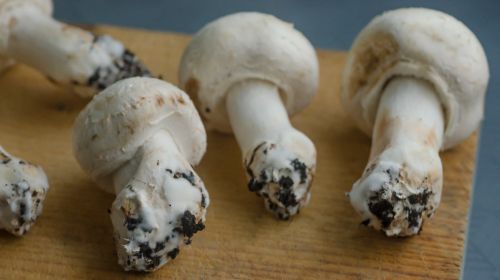Mushrooms are everywhere. In humans, they can infect the skin and nails or penetrate inside the body – especially if the immune system is weakened. What types of mushrooms are there, how dangerous they are and what helps against them.
- In order to prevent a fungal infection, such as athlete's foot, the spaces between the toes should also be dried thoroughly after showering.
- © Getty Images / Peter Dazeley
It is estimated that every tenth person in Germany suffers from a fungal infection (mycosis). Almost everyone goes through one or more mycoses in the course of their life. Foot, nail and vaginal fungus are particularly common. But there are very different types of fungi that can attack different parts of the body. In healthy people, the fungi cause annoying, but usually only mild illnesses. These can usually be treated well with medication. However, if an infected person has a weak immune system, for example due to an underlying disease, a fungal infection can turn into systemic mycosis and thus dangerous. Doctors are increasingly discovering types of fungi that are resistant to common drugs (antimycotics). Fungal infections are considered life-threatening additional illnesses in intensive care units, but they are difficult to detect.
At a glance:
These pathogens cause fungal infections
Mycoses can be caused by different pathogens. There are numerous subspecies of each genus. Some belong to the normal flora of the skin or the mucous membranes and only make people sick if they multiply excessively. Others are directly considered to be pathogens. Filamentous fungi are responsible for around 70 percent of all fungal infections, yeast for just under a quarter, and mold for only five percent of diseases.
Thread fungi (dermatophytes)
Thread fungi get their name from their appearance under the microscope. They only cause diseases on the body surface, especially athlete's foot, nail fungus, skin fungus or mycosis of the scalp and hair. The genera Epidermophyton, Microsporum and Trichophytes are particularly common.
Candida
The unicellular yeasts are particularly widespread and often colonize the skin and mucous membranes of healthy people. The species Candida albicans and Candida glabrata are particularly common. The new pathogen Candida auris, which is resistant to many antimycotics and is often transmitted from patient to patient in hospitals, has been spreading for several years. With pathological increase Candida can cause infections in the mouth (thrush), skin fungus or vaginal fungus (vaginal mycosis). Such a fungal infection can occur in both men and women.
Molds
Molds spread their spores mainly through the air and can be found everywhere. Many of them are harmless, but the Aspergillus genus can cause diseases of the internal organs in immunocompromised people. The pathogens usually enter the body via the lungs or sinuses. In sensitive people or those with bronchial asthma, inhaled fungal spores can also trigger an allergic reaction.
Mushrooms are spread through the air or doorknobs
Many fungi are naturally found on human skin. In others, the spores can be found practically anywhere in the air and are inhaled. Only when the immune system is weakened – for example due to illness, surgery or stress – do they lead to the outbreak of mycosis. Taking antibiotics can also cause a fungal infection because the active ingredient weakens pathogens as well as positive bacteria that normally prevent mycosis. Some fungi are spread through a smear infection. This can happen, for example, through shared towels or door handles or when walking barefoot in the swimming pool.
Symptoms: Mycosis manifests itself with itching and redness
Depending on which fungus is responsible for the mycosis, the symptoms are also different. Candida often causes severe itching or burning of the mucous membranes, for example in the case of a fungal infection of the vagina. Thread fungi can often be recognized by the reddening of the affected areas of the skin, sometimes also associated with itching. However, some fungal skin infections are difficult to identify, such as moccasin mycosis. It can hardly be distinguished from the symptoms of dry skin. If the fungus has spread to the whole body (systemic mycosis), this manifests itself with fever, circulatory problems and a poor general condition. Sometimes systemic mycosis also leads to septic shock.
This is how the doctor diagnoses dangerous fungal infections
If the doctor suspects that a mycosis is the cause of itching or reddening of the skin, he takes a sample, for example from the mucous membrane with a smear. He examines this sample under the microscope. There he can see which mushrooms are in which number in the sample. If there are still doubts, the fungus is propagated in a culture in the laboratory. This also happens with dander. This allows experts to more precisely determine which subspecies of a fungus it is. If the course is severe in the hospital, antigen tests and other molecular test methods as well as imaging methods can be used.
Treatment of mycosis with ointment or tablets
Simple fungal infections such as athlete's foot or vaginal fungus can usually be treated well with an antifungal agent. It inhibits the growth of fungi or kills them. Many antifungal agents work against various types of fungus (broad spectrum antimycotics). They are applied as an ointment, cream or nail polish. It is important to use the drug according to the instructions on the package insert until the end, even if the symptoms have already improved. Otherwise there is a risk that the fungi will spread again when the drug is discontinued. Some mycoses, such as nail fungus, require a very lengthy treatment. If an ointment is unsuccessful, the antifungal agent can also be used systemically, i.e. as an active ingredient throughout the body, for example with tablets. For use in hospital Infusions are available.
Mushroom poisons
Fungi can also appear in food. The white or blue mold in soft cheese is harmless. But mold on bread, dairy products, jam or hard cheese can be dangerous for people. Because mushrooms produce toxins that are harmful even in small quantities and that are not killed by heat. The toxic effect is not necessarily immediately visible, but attacks the liver in the long term, can damage the genetic make-up or can even promote cancer.
Seven tips to prevent yeast infections
There are many types of fungal infections that can be prevented. Here are a few tips on how to avoid mycoses:
Carefully dry the spaces between the toes after showering or bathing, because mushrooms grow particularly well in a humid, warm climate.
Wash all towels and bath carpets frequently at 60 degrees (guideline: once a week).
Do not exchange towels with other people.
Wear slippers in swimming pools and gyms.
Change underwear and stockings daily.
Treat abnormal areas of skin immediately.
Strengthen the immune system through a healthy diet, adequate sleep and plenty of exercise in the fresh air.


